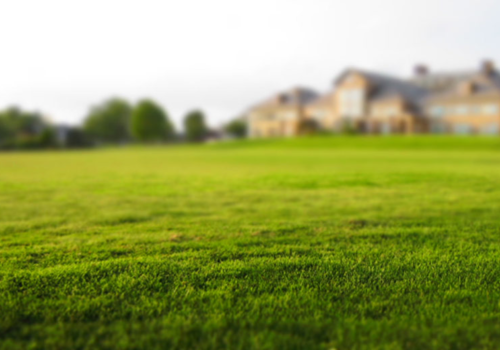Lawn scalping is a lawn care practice that involves cutting the grass extremely short, often to the point where the stems are exposed and the lawn appears almost bare. While this technique can be beneficial in certain situations, improper scalping can damage the grass, making it more susceptible to stress, weeds, and disease.
Understanding Lawn Scalping
Lawn scalping is the process of mowing the grass lower than its recommended height, sometimes even down to the soil. This exposes the grass crown (the part of the plant where new growth emerges) and can remove dead grass and thatch buildup.
Scalping is often confused with simply cutting the grass too short during routine mowing. However, true lawn scalping is an intentional process used at specific times for particular lawn types.
Why Lawn Scalping is Carried Out
Removing dead grass and debris - scalping helps remove accumulated dead grass, thatch (a layer of dead organic material), and debris that can hinder healthy growth.
Promoting a faster green-up - by removing the dead layer, scalping allows sunlight to reach the soil and warms it up faster, which can encourage new growth and a quicker spring green-up.
Preparing for overseeding - scalping can prepare the lawn for overseeding by creating a clean surface for new seeds to make contact with the soil.
When Is Lawn Scalping Beneficial?
While cutting grass too short can be harmful, strategic scalping has its benefits. Any grass can be scalped but it is better suited to warm-season grasses.
Scalping these grass types can:
• Promote new growth in early spring by allowing sunlight to reach the soil and warm it up faster.
• Remove excess thatch which can block water and nutrients.
• Reduce disease risk by improving air circulation at the base of the grass.
However, cool-season grasses like fescue, ryegrass, and bluegrass generally do not require scalping and may be negatively affected by doing so.
When to Scalp Your Lawn
Warm-season grasses should be scalped in early spring (late February to April). This helps the lawn transition out of dormancy faster and promotes healthy green growth.
Avoid scalping in summer or autumn, as it can weaken the grass and make it more vulnerable to heat stress and winter damage.
How to Scalp Your Lawn Properly
If done incorrectly, scalping can damage your lawn instead of benefiting it. Follow these steps for proper lawn scalping:
Adjust your mower height - set your mower to the lowest setting while still leaving some green growth. For most warm-season grasses, aim to cut the lawn down to 1-1.5 inches. If your grass is very overgrown, lower the mower height gradually over multiple mowings instead of cutting it too short at once.
Mow when the grass is dry - mowing a dry lawn prevents clumping and ensures an even cut. Avoid mowing wet grass, as it can lead to an uneven cut and damage the mower blades.
Remove grass clippings - after scalping, rake or bag the clippings to prevent them from smothering new growth. This allows sunlight and air to reach the soil and encourages new shoots.
Water and fertilise after scalping - lightly water the lawn after scalping to keep the soil moist. Apply a balanced fertiliser to promote new growth and recovery, such as KissMyGrass Seaweed Liquid Lawn Fertiliser.
Monitor and maintain - within a few weeks, the lawn should start growing back healthier and greener. Keep up with regular mowing at the recommended height for your grass type.
Things To Avoid When Lawn Scalping
Common mistakes that people make with lawn scalping that should be avoided include:
• Lawn scalping at the wrong time – too early will cause frost exposure while too late will damage early growth.
• Mowing too low will damage the blades of grass, while exposing the soil will lead to weeds growing and to soil erosion.
• Lawn scalping too often will cause stress to the grass and may retard its growth. Lawns should be scalped no more than twice a year.
• Preparation of the lawn prior to scalping reduces the risk of damage to the grass and promotes healthy growth.
• Always lawn scalp with sharpened mower blades. Dull blades will tear the grass that leads to disease and poor growth.
• Never scalp your lawn in extreme weather conditions such as heavy rainfall or drought. The best time is during periods of mild weather when the soil is moist.
Post-Scalping Care
• Your lawn will need to be looked after, if it is to recover correctly from lawn scalping. Watering deeply (applying approximately one inch of water) immediately after scalping will help the grass’s recovery and will encourage new growth. Take care not to overwater, however, as it can cause shallow root development.
• Your lawn will need the nutrients required for healthy regrowth so use a balanced lawn fertiliser such as KissMyGrass Premium Spring & Summer Lawn and Sportsfield Fertiliser 12.5.5+ which is rich in iron, magnesium, and seaweed for a rapid ‘green up’ and all round healthy growth.
• As the grass begins to grow back, gradually increase your mowing height. Once the grass is re-established at the correct height, regular mowing can resume.
Risks of Lawn Scalping
Although scalping can be beneficial when done correctly, improper scalping can lead to:
Increased weed growth – short grass exposes the soil, giving weeds a chance to take over. Weedol Lawn Weedkiller will kill weeds without damaging grass.
Heat and drought stress – if scalped too low, the lawn may struggle to retain moisture.
Patchy regrowth – if the grass is too damaged, some areas may not recover evenly. To repair damaged or patchy areas fast, BS Renovator - Lawn Repair Grass Seed germinates in as little as 7-10 days.
Lawn scalping is a strategic lawn care practice that, when done at the right time and in the right way, can encourage healthier growth, reduce thatch buildup, and improve lawn appearance. However, it is important to understand your grass type and follow the correct mowing and aftercare practices to prevent damage. If you're unsure whether your lawn would benefit from scalping, consider consulting a lawn care professional to assess your specific situation.
Lawn Fertiliser from Boston Seeds
Here at Boston Seeds, we supply lawn fertiliser, including granular lawn fertiliser and liquid lawn fertiliser. To work alongside our range of fertiliser products, we offer moss killer, essential for routine lawn maintenance.
For bulk or regular purchases, we welcome applications for trade accounts and will review all applications within one working day. For all other enquiries, our knowledgeable and friendly team is available with help and advice via email or over the phone on 01205 280 069.


